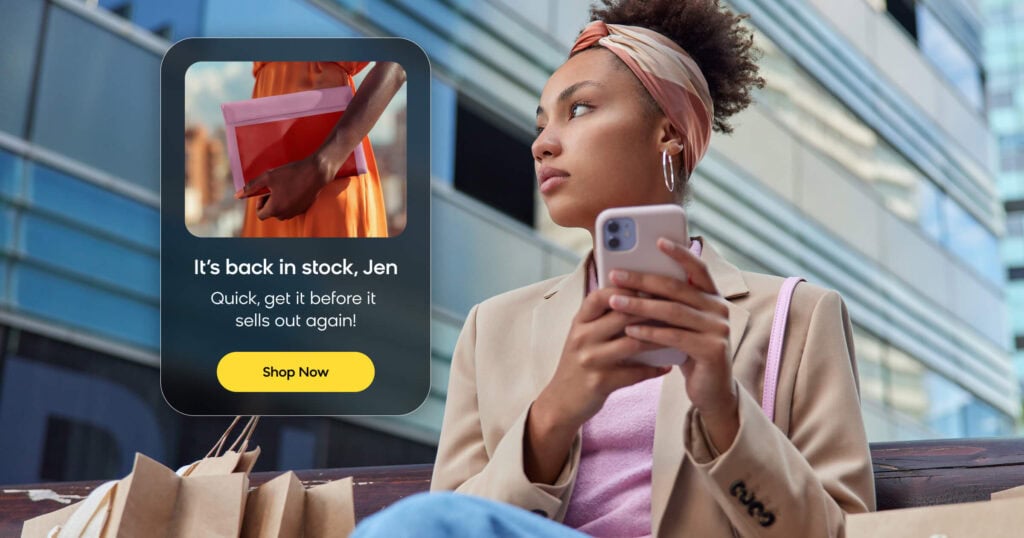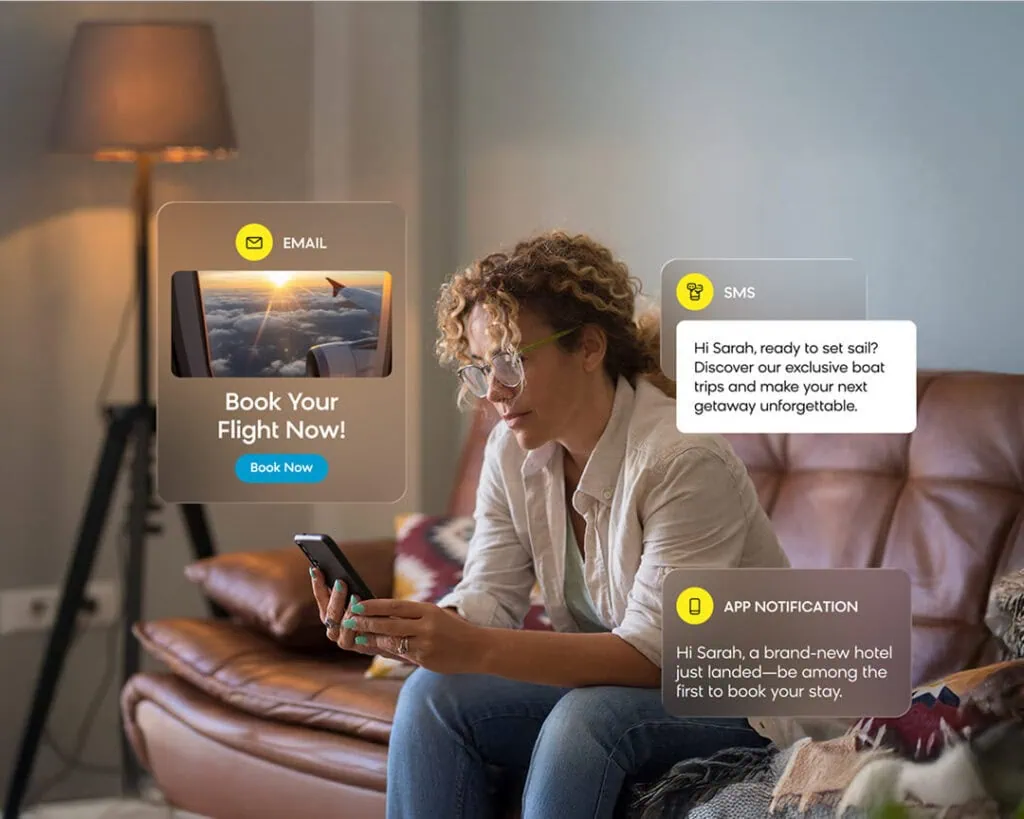As the internet becomes more privacy-centric by the day, the role of zero-party data becomes increasingly important.
But what exactly is zero-party data, and what role does it play in modern marketing, and helping to predict customer behavior? Keep reading to find out.
Key Takeaways
Beginning to collect zero-party data can take your marketing to the next level.
Zero-party data is data that a customer intentionally and proactively shares with a business.
It can include preferences, purchase intentions, and personal contexts.
The biggest advantage of zero-party data is accuracy.
Since it’s provided by the customer, you don’t have to question the source.
Zero-party data collection should be a business priority.
Companies who can creatively and compliantly collect zero-party data will effectively be able to power ecommerce personalization.
What Is Zero-Party Data?
Zero-party data refers to a customer intentionally and proactively sharing personal details with a business. It can include customer preferences, purchase intentions, personal contexts, and data on how an individual wants to be recognized by the brand.
In short, it is information that a customer freely provides to a company. It’s not inferred from how a customer behaves on your site. It’s explicitly given by a customer, typically with the expectation that businesses that collect data will reward customers with a better shopping experience.
“How often do you want to receive emails from us?”
“What type of content do you enjoy?”
“How was your most recent shopping experience in our store?”
The answers to questions like these produce zero-party data, and brands can use that personal context to create better experiences for their customers.
Forrester Research was the first to introduce and define the term, and since then, collecting zero-party data — along with the way in which it is collected — has become increasingly important for companies across the globe.
But why? It’s because customers are becoming more and more concerned about their personal data. How their data is being collected and used is much more important to many online shoppers after all the data breaches that have occured over the past few years.
With enforcement becoming more strict on governing regulations and laws like the General Data Protection Regulation (GDPR), the time to begin collecting this important type of personal data — using a constent-based process that respects customers and keeps your company protected from legal issues — is now.
Zero-Party Data vs. First-Party Data: What Are the Advantages of Every Data Type?
Understanding the importance of zero-party data is impossible without first understanding what makes it unique. To do that, you must comprehend all of the different types of data that can be collected on your customers.

In addition to zero-party data, there is first-, second-, and third-party data that companies work with. Let’s do a brief breakdown of each:
Zero-Party Data
- Data that a customer intentionally and proactively shares with a brand. It can include preference center data, purchase intentions, personal contexts, and how the individual wants to be recognized by the brand.
- The biggest advantage of zero-party data is its accuracy. Since it’s provided by the customer, you don’t have to question the source. Additionally, it is freely given to your company so there are no concerns about how the data was acquired.
- The caveat to zero-party data is the expectation of a value exchange. Customers expect something in return for giving up their information. There also can be a disconnect between what customers think and what they truly want.
First-Party Data
- Information that a company directly collects via its own channels and sources. These channels include mobile apps, websites, social media, SMS, email, and more.
- First-party data is uniquely useful because it belongs to your company — you collected it. This is a competitive advantage. It is also reliable because you know the source that it came from and there are no outside sources involved.
- The challenge of first-party data is that there never seems to be enough of it. It takes a lot of time and effort to collect this information — especially for newer customers — and you need an ample amount for it to be valuable.
Second-Party Data
- The first-party data of another company, packaged and sold. Ideally this information comes from a trusted partner, one that your business can expect to offer data quality and accuracy.
- The main advantage with second-party data is additional information on customers. As mentioned, there’s no such thing as too much first-party data. Second-party data can help drive sales and fill in the gaps, and can also be ready to use upon purchase.
- Trust is a major hinderance here. Since second-party data was not gathered by your company, you need to ensure that you trust the supplier in order to make good use of this information.
Third-Party Data
- Aggregated data collected from multiple different sources, packaged and sold by a company that did not collect the data itself. This is often sold on a data exchange platform.
- The size and scope of third-party data is its biggest advantage. Since this type of data comes from multiple sources, the quantity of information is generally massive. It is much larger in scale than the other forms of data.
- Since this data is being sold to multiple companies, your company would not have exclusive rights to this data. Purchasing third-party data comes with many of the same pitfalls as second-party data — you need to trust the source. And with more volume comes more risk of data quality and accuracy issues.
The real value in zero-party data comes from your customers’ intent to give it to you. While first-, second-, and third-party data can be collected, all of those types of data are not freely given by the customer to your brand. That matters when data privacy concerns are at an all-time high.
The Benefits of a Zero-Party Data Strategy
The ease of collection involved with zero-party data and the potential disadvantages of other data types make it easy to see why zero-party data should be a major focus for ecommerce businesses. It’s information that fundamentally helps businesses build a better relationship with customers, which has huge perks for both your business’ bottom line and your customer’s experience with your brand.
It all comes down to the customer value exchange, a concept briefly discussed earlier. But it’s a core component of a zero-party data strategy and one worth exploring further.
The heart of the concept is this — customers are willing to share data with brands in exchange for an experience that is customized to their wants and needs. Customers want personalized content, but they want to be in control of what data is shared to obtain that personalized experience with a company.
Read this next: Ecommerce Personalization: Your Complete Guide [blog]
Collecting zero-party data eliminates the “creepy factor” customers can sometimes experience with a brand. Is there any worse feeling as a consumer than being marketed to with personal information you didn’t freely provide to a company? It’s an awkward way to learn that a brand is hunting down your personal data, and it doesn’t help build a trustworthy relationship.
A good zero-party data strategy eliminates that creepiness. Because the data is collected freely and directly from the customer, it doesn’t come as a surprise when that information informs a customer’s experience. And it eliminates the guesswork for brands trying to personalize the customer journey.
Plus, capturing zero-party data goes a long way in solving the personalization-and-privacy paradox, a true catch-22 for marketers.
The relationship between personalization and privacy is tightly interwoven — modern customers expect true personalization from businesses. They want experiences that cater to their specific wants and needs. But increased government legislation and browser privacy features make it much harder for companies to offer things like bespoke content, customized campaigns, and tailor-made product recommendations.
The solution to this problem is zero-party data. As long as there is transparency around the value that customers get in exchange for their data, consumers can choose to share their information if they desire a personalized experience. That choice generally leads to more convenient and seamless shopping experiences with your brand.

How To Create a Zero-Party Data Strategy
There are many different ways to go about collecting and utilizing zero-party data. To launch a successful zero-party data strategy, it’s important to take the following ideas into consideration:
- Align it with your overall customer data, content, and marketing strategy. Zero-party data needs to inform and cooperate with all your marketing efforts. Make sure your channels, campaigns, and analytics all work together to create the customer experience your audience expects.
- Combine zero-party data with your first-party data by integrating existing systems. Data silos are detrimental to any good marketing strategy. Unifying data needs to be a priority.
- Clearly communicate the value exchange to your customers. Let them know how your brand will use their data and how it will benefit their personal experience.
- Make zero-party data a part of your overall omnichannel experience. Collecting zero-party is all about customer interaction, and there are plenty of channels and ways to offer valuable customer connections — whether it’s through emails, SMS campaigns, on-site experiences, or other means.
How To Collect Zero-Party Data
The best part about zero-party data is how creative you can get with your collection methods. Creative marketers have come up with a multitude of innovative ideas to collect this data, all while keeping the process an entertaining experience for customers.
Consider Bloomreach customer My Jewellery, a clothing jewelry retailer based in The Netherlands. My Jewellery created the style profile test, a quiz that helps shoppers identify which pieces fit their own personal style. By completing the prompted questions and defining their own personal preferences, customers were guaranteed to see more of the products that they prefer — and the company gathered valuable zero-party data from both interested visitors and repeat customers.
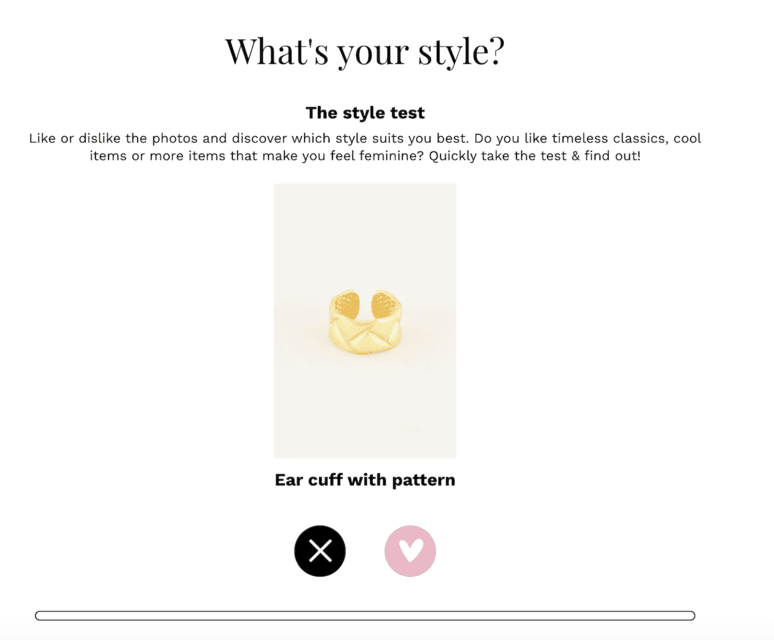
With the data acquired from this simple quiz, My Jewellery was able to personalize each user’s shopping experience, making it easier for them to find items they love and drastically cutting down on the steps between browsing the site and a completing a purchase.
The quiz upgraded customer personalization, increased customer service, and curbed additional risk-taking in data collection — a win-win-win.
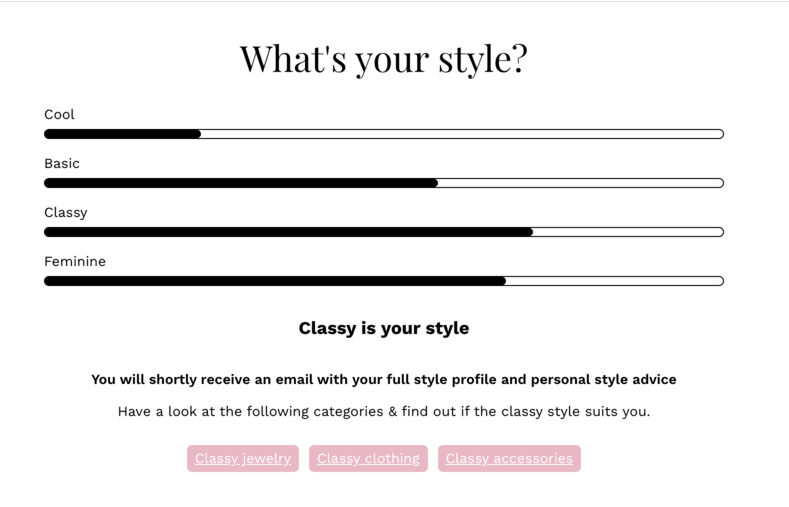
My Jewellery’s gamification of zero-party data collection is a tried-and-true way to create valuable interactions. but there are plenty of other methods for businesses to employ.
Other zero-party data examples include:
Creating social media polls for customers to interact with
Offering contests for customers to enter by inputing their information
Prompting customers to complete user profiles
Asking customers to rate and review their purchases
Messaging customers questions and surveys after they complete a purchase
Some methods are more in-depth than others, but there really is no limit to how imaginative you can get with the process. However you choose to collect zero-party data, cultivating the right relationship with your customer should be your main goal. It all comes down to what works best for your audience and your brand.
Zero-Party Data and Ecommerce Personalization
If you’re a competitive business in today’s market, you’re fully aware of the importance of ecommerce personalization.
At Bloomreach, we define ecommerce personalization as the practice of using commerce data responsibly to get to know, guide, and impress your customers with experiences that are so relevant and contextual, they feel like magic. Ecommerce personalization spans cross-channel, on-site, and in-app, resulting in measurable journeys that engage and lead customers through brand awareness to product discovery to repeat purchases.
But what does zero-party data and ecommerce personalization have in common? Quite a bit, really. They are both integral parts of commerce data — the combination of customer and product data that fuels ecommerce personalization efforts.
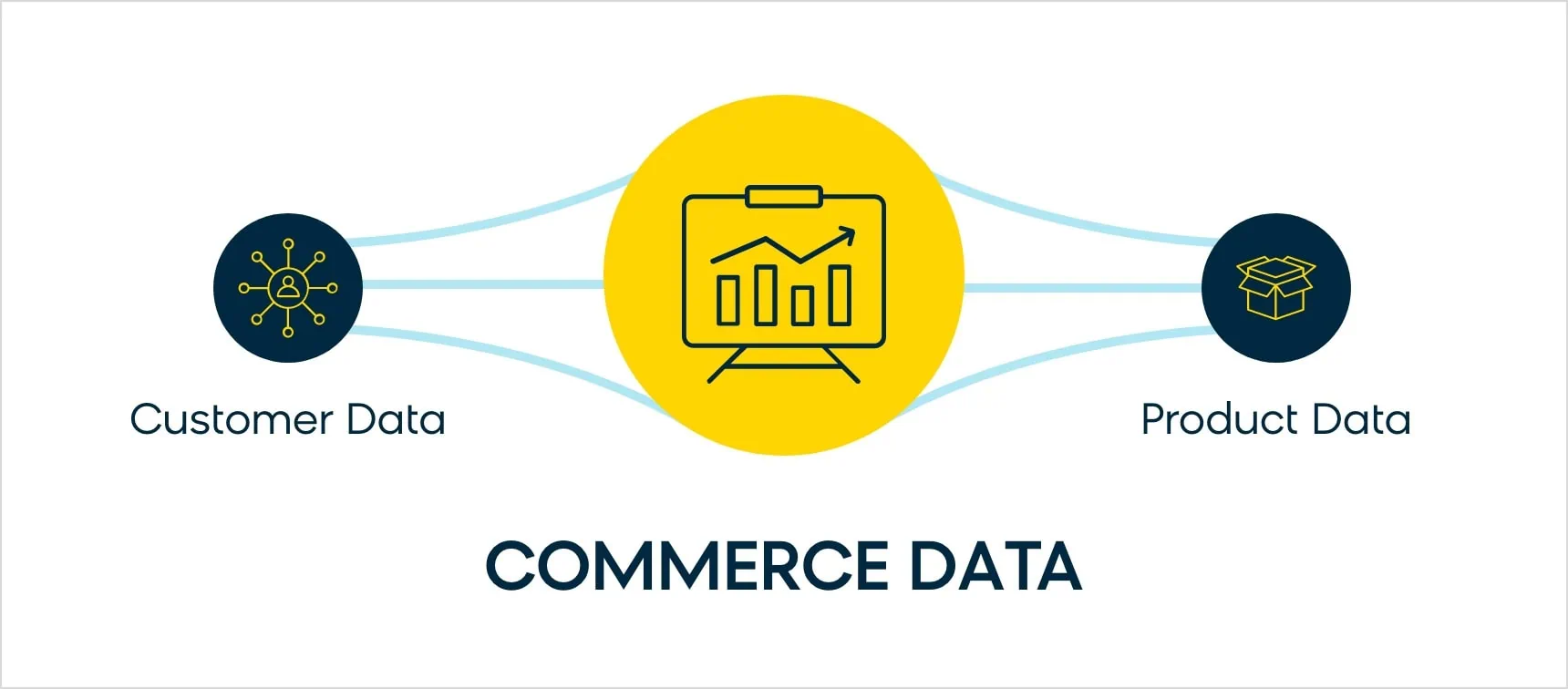
Collecting zero-party data is one of the most enlightening and compliant ways to feed the customer data portion of the commerce data equation. Since customers freely give you their data themselves, you don’t need to worry about potential non-compliant collection procedures. Plus, it is accurate and trustworthy, allowing you to create personalized experiences based directly on your customer’s needs.
With zero-party data incorporated into your commerce data, you’re well on your way to optimizing your ecommerce personalization efforts, connecting customers with the products they desire, and helping your company increase revenue and facilitate brand loyalty.
Harness the Power of Your Zero-Party Data With Bloomreach and Ansira
The Bloomreach Commerce Experience Cloud is the perfect solution to help you launch or revamp your zero-party data strategy. Our powerful Discovery, Engagement, and Content offerings help companies achieve true ecommerce personalization and drive unparalleled business growth.
Our trusted partner Ansira is a marketing technology and services company laser-focused on creating exceptional customer experiences. Recently recognized by Forrester as a ZPD Service Provider and also named a Strong Performer in Loyalty, Ansira is ready to help you orchestrate a successful data strategy.
With strong partnerships with a host of full-service agencies like Ansira, Bloomreach is equipped to help your company take its zero-party data collection strategy to the next level. Learn more about Bloomreach Engagement to see exactly how it can benefit your ecommerce business.




